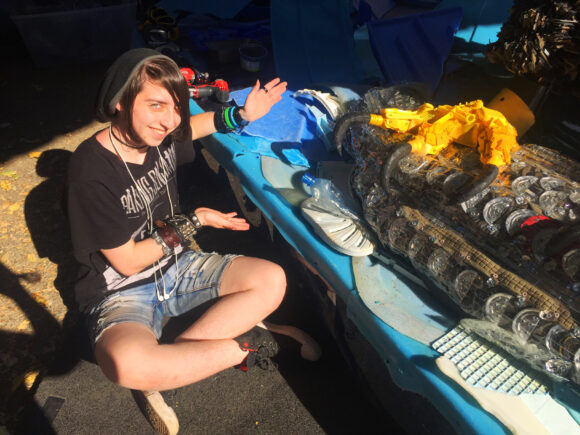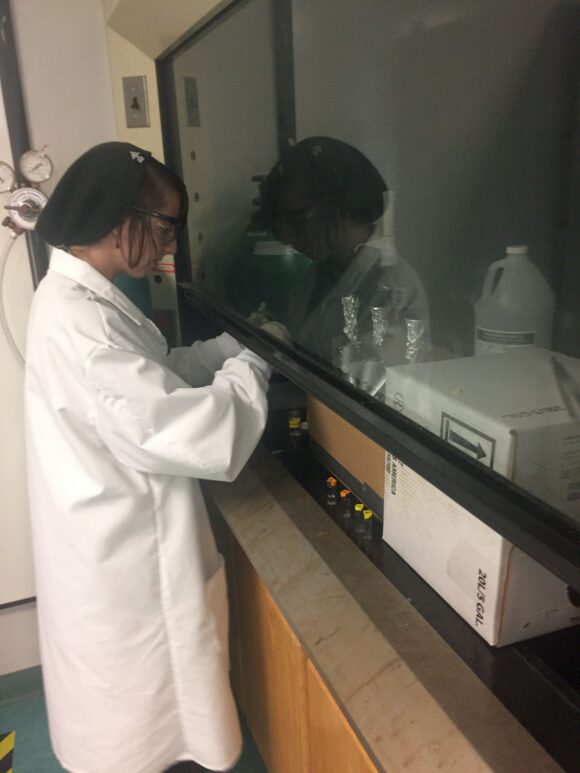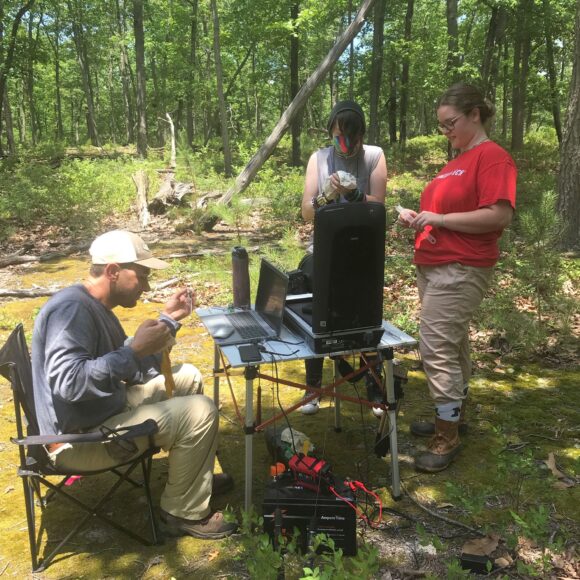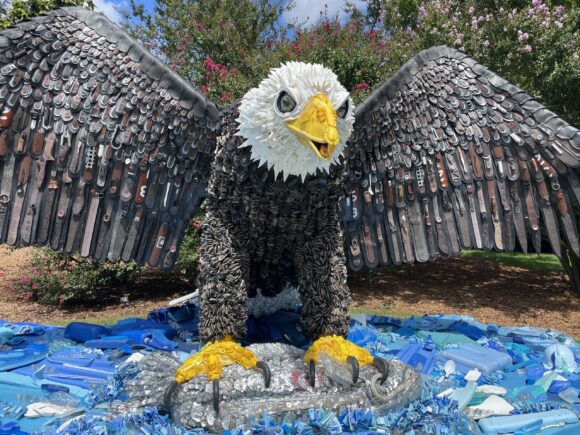
Mox Engelman (SEBS’23) working on the bald eagle sculpture ‘Rosa’ for the non-profit Washed Ashore.

Mox Engleman working in the lab.
The Student
Mox was a Scarlet Knight even before their freshman year. Pursuing a Ph.D. in marine science has been a dream of theirs since they were eight years old. During their senior year in high school one of their teachers told them about a Stockton University professor who studies microplastics in fresh water at Stockton University, Mox was immediately intrigued and wondered if similar work was being done at Rutgers.
Being a child of a Rutgers alumna, Mox had been going to Ag Field Day for years. Auspiciously, at the April 2019 Ag Field Day, they went to their favorite tent – Marine and Coastal Sciences — where they asked whether anyone in the department was doing microplastics research and whether they needed an ‘extra pair of hands.’ Mox ended up doing research with Dr. Grace Saba on microplastics in salt water that summer before they’d ever set foot on campus as a freshman!
Rutgers was always high on Mox’s list, but the fact that they could double major in marine science and visual art at a premiere marine and coastal sciences department at SEBS and the renowned Mason Gross School of the Arts, cinched the deal. Motivation should be their middle name because they are also minoring in creative writing, are in the SEBS Honor Program and are about to present their George H. Cook Scholars program thesis.
“The Honors Program has been a lot of work, but very beneficial to my undergraduate career,” said Mox. “The staff at the program provided me resources before I even entered and lots of encouragement early on.”
“Mox is truly exceptional,” said Dr. Henry John-Alder, Mox’s George H. Cook Scholars program advisor. “Few students have the curiosity, capability, courage, and self-confidence to cover the arts and humanities together with the natural sciences in their undergraduate curricula, and fewer still can complete such an eclectic and wide-ranging program with the near-perfect academic record that Mox has amassed.”

Mox Engleman, Center doing field work for their George H. Cook Honors Project, with fellow researchers.
The Scientist
Mox Engelman’s honors research project is titled “Effects of Age, Sex, Size, and Mite Load on Coloration in Eastern Fence Lizards.” Eastern fence lizards are common in parts of the New Jersey Pinelands National Reserve, and Mox conducted their research in a section called Colliers Mills Wildlife Management Area, not far from Six Flags Great Adventure.
The project consisted of three main “steps:” field work capturing and scanning the lizards, taking biometric measurements, then analysis in photoshop to do scale counts and color analysis/measurements, and finally, the statistical analysis of findings. “Basically, we are looking for correlations between various physiological aspects and the development of the blue and black coloration that Eastern fence lizards have on their ventral (belly) side,” explained Mox.
As adults, fence lizards are characterized by dramatic sex differences in coloration (sexual dichromatism), in which only the males develop to have vivid blue gular (throat) and abdominal (belly) color patches. At hatching, males cannot be distinguished from females on the basis of coloration, but by 12 months of age, coloration of males and females is distinctly different. “Prior to Mox’s project,” explained professor John-Alder, “it was unclear at what age and size males develop their blueness, and possible deleterious effects of ectoparasitism were unknown. Mox’s George H Cook research has provided definitive resolution to each of these issues and thus provides the necessary context of natural history!”
“The research has been fascinating and a challenge,” remarked Mox.
The Artist
Interestingly, Mox’s background in visual art and color theory and analysis proved to be a great complement to professor John-Alder’s experience with lizards. “Should we use CYMK or RGB or HSB to characterize color?” These questions were new to the professor, but the daily fodder for Mox. “In our ensuing discussions as Mox developed their thesis, we learned from each other in ways I hadn’t anticipated, and the whole George H Cook experience with Mox has been tremendously rewarding!”
Combining their interest in microplastics, their concern for its effect on the marine environment and their passion for visual art, Mox participated in a unique internship before their junior year at “Washed Ashore.” This non-profit, created in 2010, collects plastic pollution and turns it into sculptures of creatures affected by this plastic debris. They have four traveling exhibits, ongoing sculpture making, a standing gallery in Oregon, and a multitude of other projects.

Mox helped to create Rosa, the Washed Ashore sculpture made out of plastic garbage salvaged from the sea.
Mox worked on Rosa, a giant sculpture of a bald eagle, including an outer decorative layer made of broom heads, flip flops, buoys, gun stocks, a hot wheels car, sunglasses, pill bottles, a Teenage Mutant Ninja Turtle mask, kiddy pool pieces, and even a cell phone.
“Visitors have commented that the sculptures are both beautiful and sad,” remarked Mox, who urges that donations be made to this amazing organization to restore our oceans.
Mox is interested in both sculpture and photography and has created an impressive body of work in both areas as can be seen in the gallery below.
Their dedication to both the arts and the sciences is balanced and genuine and their ultimate goal is to pursue a career that combines them in a truly integrated way.
After working on two majors and a minor, as well as the honors program and the George H. Cook Scholars Program. Mox intends on taking a well-deserved gap year to enjoy a break from studying. They plan to work to make money and then head onto grad school to pursue a Phd. in Marine Biology.
As professor John-Alder remarked, “Mox seems destined to become a contemporary polymath!”
Check out Mox’s Instagram page at alt.kid_art.












